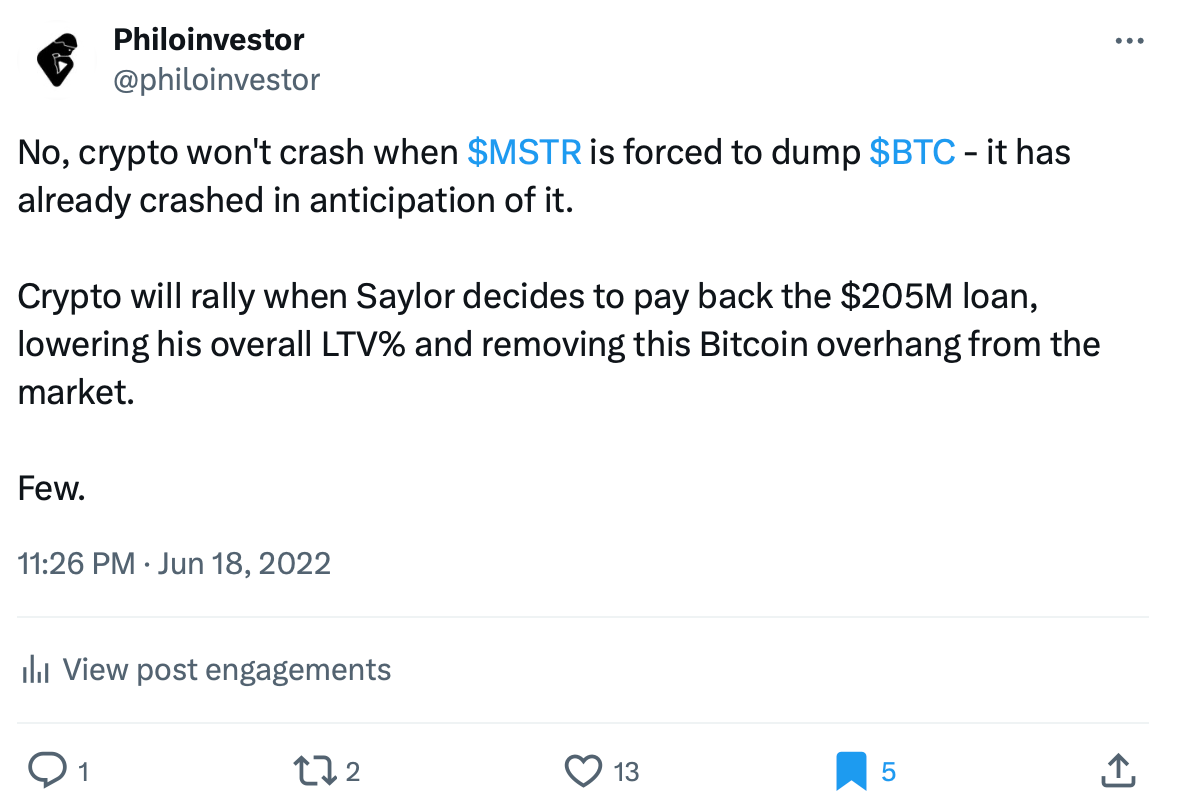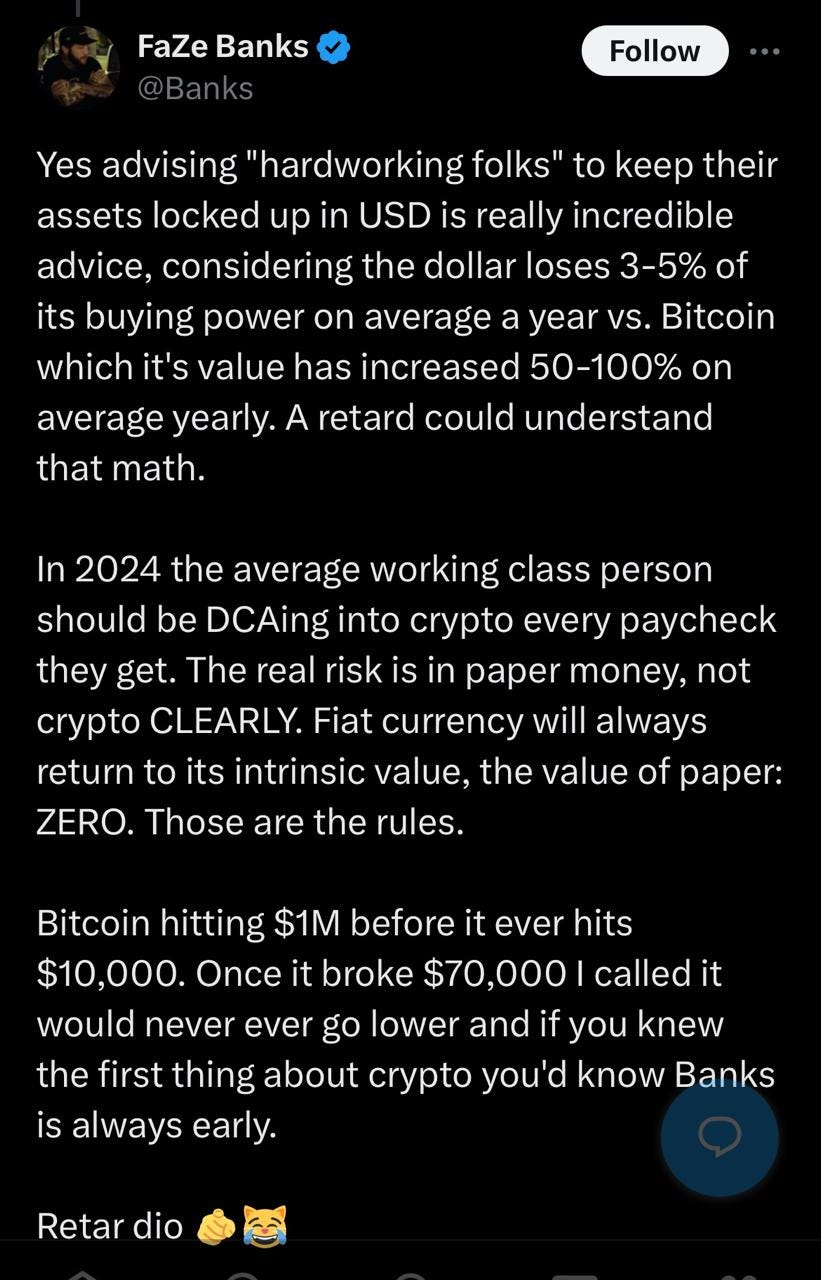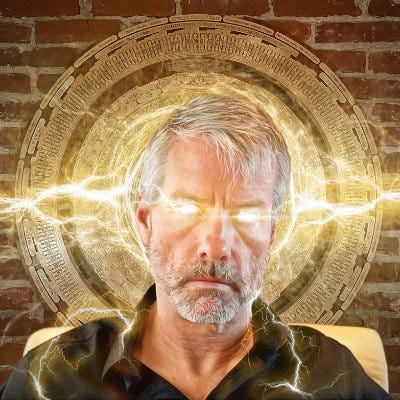💥DUMP YOUR CRYPTO 2.0💥
Saylor's Cryptonite. Nailed the top in late '21, will do the same now.
Bitcoin’s Superman is Michael Saylor. Superman’s greatest weakness was Kryptonite, Saylor’s greatest weakness is Cryptonite.
So what’s Saylor’s Cryptonite? We will find out today, read on.
Reading Time: 13 Minutes.
On October 27th 2021, I published Dump Your Crypto to share my perspective on the crypto market at the time. In the piece I analyzed crypto cycles dating back to 2017 and explained why I believed there was no upside potential from those price levels at the time.
Well, that was the top in Crypto with BTC dropping 78% peak to trough by late 2022… Nailed it, as they say.
We analyzed Crypto Cycles #1 and #2 in the first piece — in this one we will start at #3.
Have a read to get yourself up to speed 👇
The Drivers are Different
The really interesting thing is that the drivers (i.e. crypto fundamentals) to Cycle #3 barely have anything to do with Cycle #2 — in this case they are even more abstract, making things more complicated and possibly even more dangerous.
—> Let’s break them down intellectually, talk about their potential, credibility and the possible scenarios for how things might unfold.
In the first piece, Cycle #2 was at the peak of the boom stage — let’s review the bust stage now before moving to Cycle #3 (the current one).
The bust stage of Cycle #2 saw BTC plunge by nearly 80%.
BTC touched $15,000 and hovered around those levels from June ‘22 till the end of the year.
At the time, the market was worried sick that BTC would crash (further!) due to Microstrategy’s leveraged BTC stash (sound familiar?)!?!?!
All the big ideas about utility and fundamentals had gone out the window just because BTC was dropping… Put this to the side and we will get back to it later.
This is what I had to say when BTC was at less than $18,000 — $2k shy of the actual bottom in November of the same year 👇
It was a “buy the rumour, sell the fact” dynamic but with a twist. Basically, the market was saying BTC will drop — I was saying it had already.
And that’s where Cycle #3 started 👇
Crypto Cycle #3
Crypto Cycle #3 started on November 15th ‘22. That was the low of cycle #2, ~$15,500 per BTC.
Markets adopt theses, and they test them with reality: MSTR’s BTC stash wasn’t liquidated, BTC didn’t drop further, and equity markets bottomed right around that time too — supporting overall sentiment.
BTC is now hovering around $100K, roughly a 6.5X since the start of the cycle.
What were the drivers / fundamentals that led to this bull cycle?
Crypto Fundamentals
Excerpt from Dump your Crypto 1.0 👇 on the market narratives in Crypto.
There is another very important layer in this crypto uptrend, and that is inflation. Speculators seem to believe that Bitcoin (and crypto in general) is an inflation hedge. What makes Bitcoin a natural inflation hedge I don’t know. But I can tell you that narrative follows price, and not the other way around.
In the same way that analysts revise their price targets upwards when the market is rallying, and revise them down when the market is crashing; the narrative around crypto will change as the market changes direction. Analysts, talking-heads and the narrative around a market moves pro-cyclically with the price of said market.
As explained above — NARRATIVE FOLLOWS PRICE.
During Cycle #3’s sharp ascent the fundamental layers were as follows
1. The SEC approves Crypto ETFs
ADOPTION & MAINSTREAM-ISATION
This induced FOMO straight into the heart of speculators looking to make a quick buck.
“I’ll just jump ahead of the ETF train", they thought.
This pushed the price of main coins (BTC & ETH) higher, which gave more credence and appeal to the idea of Crypto-related ETFs. The Crypto-ETF vehicle was a way for those that couldn’t or wouldn’t buy crypto directly, to finally get exposure to it.
This is basically how I understood the process:
The approval of Crypto-related ETFs is considered a positive for Crypto, which gets bought and bought because of this development. ETFs getting listed means they attract inflows from “cash” buyers — which means the market makers of the ETFs have to go out and buy actual crypto, which of course increases direct demand for Crypto.
Or put more simply: Crypto ETFs launched, Crypto moving up, ETFs bid --> ETFs need to buy more Crypto --> Saylor gets a case of the FOMOs --> Crypto moves up because he's buying --> ETFs getting bought out more --> Saylor levering up to not miss this one-in-a-lifetime to buy BTC.
Do you see the loop here? 🔄
As of now, Bitcoin ETFs hold >1mln Bitcoins with AuM passing >$100bln as of this week. These are the biggest ones as of a few days ago 👇
Assuming total supply of 21mln Bitcoin and $100,000 per BTC means Bitcoin’s market cap sits at $2.1 trillion. But I discount that by 50% because there are a lot of lost Bitcoins and Bitcoins that never trade.. So ETFs currently control 10% of Bitcoin’s tradable market cap, at a minimum.
—> This means what happens with the ETFs (e.g. flows) is very important to how the actual spot market of BTC behaves. The ETFs are not passive reflections of the BTC market, they are active participants. Take this into serious consideration.
In other words, it’s not the Spot BTC market that wags the ETFs — it’s the ETFs that wag the Spot BTC market. 🐶🔄
2. Bitcoin as a Store of Value (SoV) and Reserve Asset
In previous cycles, Bitcoin was promoted as an actual currency. Crypto adopters were proud to pay in BTC, and even prouder to accept payments in BTC.
Remember all that? Well, it failed massively. Bitcoin is not really used as a currency for payments — and all the talk of lightning networks and lower cost transactions did not amount to much.
But then Bitcoin started to get promoted more as a Store of Value / Reserve Asset — I include the “inflation hedge” angle into the same theme.
This tweet reflects well the narrative/hype promoted by Bitcoin Maximalists on the “utility and fundamentals” of the digital coin.
The Big Idea & Bitcoin Determinism
First-Level Tulip Bubble
It seems that BTC is now promoted as a hedge against the debasement of USD.
“Why hold USD which falls in value 3-5% a year, and not BTC which goes up 50-100% a year on average?” …They rhetorically ask.
Well, that would be a great trade if there weren’t so many traps — namely, that BTC does not steadily appreciate by those amounts! 🤦🏻♂️
BTC can fall by 80%, and if you use leverage on that trade — you’re screwed!
But even if it did appreciate by crazy percentages — that was the past, who can guarantee what will happen in the future? 👇
This is the typical trap of LINEAR EXTRAPOLATION — ever heard of this term? Didn’t you learn it in your studies? Here’s your chance, check out philomastery.com
BTC maximalists here seem to believe that the future is a CERTAINTY — that’s how they are behaving: I call this BITCOIN DETERMINISM.
“The real risk is in paper money, not crypto CLEARLY. Fiat currency will always return to its intrinsic value, the value of paper: ZERO. Those are the rules.”
The arrogance is notable, I won’t say anything more.
Second-Level Tulip Bubble (i.e. Keynesian Beauty Contest)
But I don’t think BTC is going up because it’s being bought by people that want to hedge against the debasement of the Dollar — that’s just a beautiful excuse.
BTC is going up because, well, it’s going up. Every move needs a narrative, it doesn’t mean the market believes the story.
Which brings us to Crypto Superman… Michael Saylor.
3. Microstrategy as a Bitcoin Treasury Company
Every bull market has a poster boy, right? Michael Saylor is the poster boy for this one — he is Crypto Superman.
MSTR started buying BTC on August 11th, 2020 — they are up ~10X on that purchase. They have slowly accumulated BTC since then, quickening the pace since early 2024.
But the company has doubled its BTC holdings since September 5th — BTC was at $50K then. Again, it worked out for Saylor because the Trump election propelled Crypto higher (we’ll get to that later).
This is their Micro-STRATEGY
Simply speaking, they are shorting fiat to buy crypto — more specifically, shorting Dollars to buy BTC. This is the trade, that’s it. It works as long as BTC/USD moves up, it perishes when BTC/USD moves down.
The “Bitcoin Treasury Company” strategy is to issue debt and equity to buy BTC.
Their actual long-term target is to raise $21bln in Equity and $21bln in Debt to do so… They believe the number 21 is magic, OK.
No wonder BTC is moving up, right?
They are levering up to buy BTC from the open market. They are the marginal buyer, and everyone knows it — and the market is trying to make a buck off of that.
The incentives of those investing in MSTR debt and equity is a bit harder to decipher though.
Let’s think about it…
Saylor’s “Infinite Money Glitch”
Convertible Debt
This one is obvious, even though the Converts that MSTR issues mostly yield 0% — they offer an asymmetric upside. The downside is more or less protected, while the upside is open in case that MSTR continues to create value in their BTC book (or MSTR stock just continues to move up).
But that only matters at maturity, i.e. when the Convertible Bond matures and the company either owes the capital back to the bondholder or the bond converts to shares.
Pre-maturity there is something else in play. Recall that a convertible bond is a bond + a call option on the underlying equity.
And you know how options work, the more the volatility the more the value. In the case of a 5-year convertible bond, the embedded call option also has a 5-year maturity. And the longer the maturity, the longer the time value — which helps in increasing the option value!
And so, when MSTR issues convertible debt — buyers swoop it up because MSTR prices it in such a way where the buyers get to show a gain as soon as the convert trades.
(More technically, MSTR prices it at a volatility somewhat lower than actual volatility, allowing the buyers to show again when the convert starts to trade.)
Then, they get to trade the convert as it moves with the volatility of the underlying (i.e. MSTR stock) to make gains. Basically, the money here is the volatility of the underlying. Convertible arbitrage traders and funds love that — because they get to make money off it.
And Saylor and MSTR love this because it enables them to raise capital at prices much higher than their current equity price, which they then use to buy BTC — and boast to shareholders that they increase Microstrategy’s BTC stash without diluting shareholders (Positive BTC Yield).
ATM Equity Offerings
Besides issuing convertible debt which converts at prices ~50% higher than the current share price, MSTR issues expensive equity and uses the capital to buy more BTC.
I say “expensive” equity because MSTR equity does not trade at NAV — it trades above that. This slide from MSTR-Tracker.com gives a good snapshot of the dynamics in play.
Right now the NAV Premium is 2.2X — meaning MSTR can issue equity at $2.2 while only giving up $1 in book value. To an extent, this is free money. And MSTR uses that “free money" to buy up more BTC, strengthening its stash.
There seems to be a narrative in the market that MSTR deserves this valuation premium because it can seemingly raise cheap money and print BTC out of nowhere…
Michael Saylor’s personality cult also helps the stock, as fanbois flock to the stock — keeping its valuation high. Personally I think he’s a clown, but anyway.
Saylor’s Cryptonite 💥
What could take down this sloppy mess of degenerate financial engineering? Because there’s always an achilles heel, make no mistake.
Here are my thoughts.
Volatility in BTC, and hence MSTR, dies off: This would make the pricing of the next Convertible Debt issue from MSTR more costly, impeding MSTR’s ability to “Infinite Money Glitch” efficiently.
Remember, MSTR is the marginal buyer right now, when MSTR stops buying and the market figures it out — things will start to faaaaade….
Many seem to believe that the only way is up for BTC, but they think too linear. “Don’t be so linear.” —Philo
Even worse than volatility dying off, BTC starts to fall in value. As shown in our MSTR-Tracker slide above, MSTR’s average BTC price right now is at $60,000; a 40% drop from these levels.
In Crypto markets, that’s a day’s work. Remind me, who will lend MSTR in this scenario? Who will subscribe to MSTR’s equity issuance in this scenario?
The NAV Premium would move back to 1, and probably even below.
MSTR then becomes a levered BTC holding company with convertible debt at 0% interest, probably underwater on their BTC and an inability to refinance that debt at the same terms…
MSTR’s BTC stash would then become (once again) an anchor for Bitcoin, pulling it and keeping it down until something breaks.
Best of luck!
4. Trump Presidency & the Bitcoin Strategic Reserve
We have already written on the pro-Crypto bias of Trump/Vance. That’s why crypto spiked after November 6th — and it’s still riding high on those headwinds.
Meanwhile, Eric Trump is hyping BTC up talking about the target of $1mln per BTC and that Donald will be the most pro-Crypto president in history.
—> All this rhetoric is influencing serious investors. Crypto is no longer alternative, it’s mainstream. FOMO!
Trump even appointed a Crypto Czar while Gary Gensler, the former head of the SEC which was very critical of Crypto and led a crackdown against the sector has now resigned.
And if the fact that the POTUS, his family and his whole administration is hyping up Crypto were not enough — we have this idea of a Bitcoin Reserve! 🤡
Bitcoin National Reserve?
Senator Lummis (R-WY) introduced her Bitcoin Act this July, which would mandate the purchase of 1mln Bitcoins by the US and hold it for 20 years. Total Bitcoin supply is at 21 million.
“We have the money now, but we will no longer be holding it in US dollars and assets that are designed to debase at least 2% per year, we’ll be holding it in an asset that will grow in value.”
I hope you can see the joke in this….
—> This used to be the position of early Bitcoin adopters, those who fought for an alternative to the US dollar away from the control of the Fed and the government.
But now it seems Bitcoin has come so far that even a US Senator is talking up Bitcoin as an alternative to the dollar! She seems to be suggesting that the dollar is “designed” to debase while BTC will grow in value. Nice… 🤦🏻♂️
—> This narrative ties back to our point #2 above on Bitcoin as a Store of Value and Reserve Asset.
This narrative is dangerous for a number of reasons. First, it can’t be refuted until after the fact. That is to say, until after it’s obvious that BTC/USD doesn’t only go up.
Second, when the US Government itself wants to build a BITCOIN RESERVE as if it’s stockpiling oil for a rainy day — then that gives irrefutable legitimacy to BTC. Everyone will want a piece, and those who own some will never sell.
Layer on top of all that the illiquidity of the coin and you can get crazy results.
But maybe the crazy result is already here — at $100K per BTC. Maybe the market has already front run Saylor’s antics, Trump’s bullishness and Senator Lummis’s ideas about a Bitcoin Reserve being enacted into law.
You know, markets tend to anticipate and price in developments before they happen. Maybe there are no buyers left.
Who is the marginal buyer again?
In Conclusion
Knowing what you now know about the dynamics of Crypto ETFs, the Micro-strategy in BTC and financial engineering, the Trump bullishness and the fact that we are probably at the peak of the Bitcoin hill — what’s the risk/reward on this?
Sincerely,
Philo 🦉















BTCUSD has increased 5% since this was written. Almost 10% since your "cough, cough" chat note. What exactly is your price prediction and in what time frame please?
Thanks. I think it explains your approach. The issue, as you know, is that open predictions are always right and rarely helpful. Me saying: Nvidia will go down, BTC will go down then up, EUR will collapse. Always true at some point.
Of course % "here or there" matters. A thesis being correct does not buy you anything, a call that is 10% off on 10 BTC is ~$100,000 less to blow on degen shit. If a % doesn't matter, why comment on moves that support your pov, eg BTC down 3-4%.
Specific and wrong with clearly detailed thinking and a transparent performance record is helpful. Full long term, market trends, non obvious.
I think you should decide which you are. Otherwise you risk becoming the FT= noise. My small, humble feedback. Take or leave